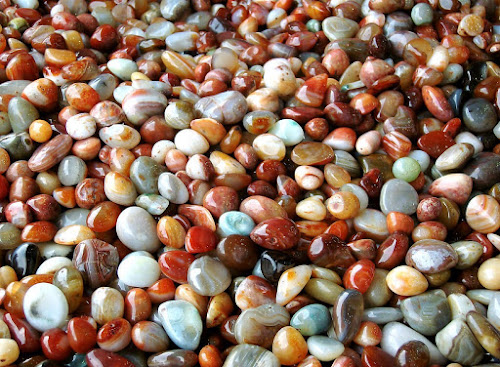Incorporating Mexican Beach Pebbles in Water Features and Ponds
Water features and ponds are captivating elements that add tranquility and aesthetic appeal to any garden or landscape. One way to enhance these features is by incorporating Mexican beach pebbles, known for their smooth texture, natural colors, and versatility. These pebbles not only elevate the visual charm of water features but also offer practical benefits. Here’s how to incorporate Mexican beach pebbles into water features and ponds effectively.
Aesthetic Enhancement
Natural Beauty: Mexican Beach Pebbles come in a variety of colors such as black, grey, red, and green, which blend seamlessly with natural water elements. Their polished, smooth surfaces reflect light beautifully, adding a dynamic and serene quality to ponds and water features. These pebbles create a harmonious and natural look that enhances the overall aesthetic of the water feature.
Creating Contrasts: Use Mexican beach pebbles to create striking contrasts with the water and surrounding greenery. For instance, dark pebbles can provide a bold background that makes the water appear clearer and plants more vibrant. Conversely, lighter pebbles can brighten the area, making it feel more open and spacious.
Accentuating Edges: Placing Mexican beach pebbles along the edges of ponds and water features helps define their shape and structure. This not only enhances the visual appeal but also creates a neat and organized appearance. The smooth, rounded pebbles contrast beautifully with the angular lines of man-made features, adding a touch of natural elegance.
Practical Benefits
Erosion Control: One of the practical benefits of using Mexican beach pebbles in water features is their ability to control erosion. When placed along the edges of ponds and streams, these pebbles help stabilize the soil and prevent it from washing away. This maintains the integrity of the water feature and reduces maintenance.
Improving Water Quality: Mexican beach pebbles can contribute to better water quality in ponds and water features. Their smooth surfaces are less likely to harbor algae and debris compared to rougher materials. Additionally, the pebbles can act as a natural filter, trapping sediments and preventing them from clouding the water.
Facilitating Drainage: The permeability of Mexican beach pebbles allows for excellent water drainage. This is particularly useful in preventing waterlogging around the edges of ponds and in areas with heavy rainfall. Proper drainage ensures that the surrounding landscape remains healthy and vibrant.
Steps to Incorporate Mexican Beach Pebbles
Design Planning: Before incorporating Mexican beach pebbles into your water feature, plan the design. Consider the size, color, and placement of the pebbles to achieve the desired aesthetic and functional outcome. Sketching a layout can help visualize how the pebbles will enhance the water feature.
Preparing the Area: Clear the area of any debris, weeds, or unwanted materials. If necessary, level the ground around the water feature to ensure a stable base for the pebbles. Installing a weed barrier fabric can prevent weed growth and make maintenance easier.
Placing the Pebbles: Begin by placing the larger pebbles along the edges of the pond or water feature. This helps define the shape and provides stability. Gradually fill in with smaller pebbles, ensuring even distribution. For a natural look, avoid placing the pebbles in straight lines; instead, create gentle curves and undulations.
Integrating with Other Elements: Mexican beach pebbles can be combined with other natural elements like rocks, driftwood, and aquatic plants to enhance the overall design. The combination of different textures and materials creates a more dynamic and visually interesting water feature.
Maintenance Tips
Regular Cleaning: Rinse the pebbles periodically to remove any dirt or algae build-up. This can be done using a garden hose or a pressure washer on a low setting.
Seasonal Upkeep: Perform thorough maintenance at the beginning of each season, checking for any displaced pebbles or build-up of debris. Replenish pebbles as needed to maintain an even and attractive layer.




Comments
Post a Comment